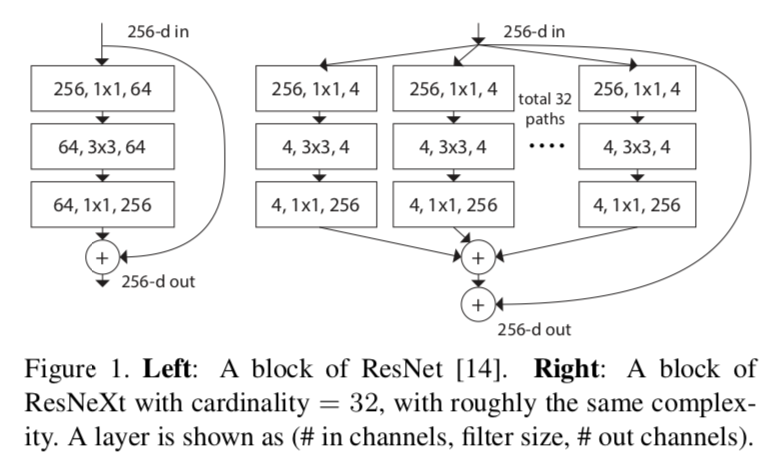ResNeXt101


模型描述
ResNeXt101-32x4d 是在 Aggregated Residual Transformations for Deep Neural Networks 论文中介绍的模型。
它基于常规 ResNet 模型,将瓶颈块内的 3×3 卷积替换为 3×3 分组卷积。
该模型使用 Tensor Cores 在 Volta、Turing 和 NVIDIA Ampere GPU 架构上以混合精度进行训练。因此,研究人员可以获得比不使用 Tensor Cores 训练快 3 倍的结果,同时享受混合精度训练的优势。该模型针对每个 NGC 每月容器发布进行测试,以确保随着时间的推移保持一致的准确性和性能。
在使用混合精度进行训练时,我们使用 NHWC 数据布局。
请注意,ResNeXt101-32x4d 模型可以使用 TorchScript、ONNX Runtime 或 TensorRT 作为执行后端,在 NVIDIA Triton 推理服务器上进行推理部署。有关详细信息,请查看 NGC
模型架构

图片来源:Aggregated Residual Transformations for Deep Neural Networks
图片显示了 ResNet 瓶颈块和 ResNeXt 瓶颈块之间的差异。
ResNeXt101-32x4d 模型的基数等于 32,瓶颈宽度等于 4。
示例
在下面的示例中,我们将使用预训练的 ResNeXt101-32x4d 模型对图像执行推理并呈现结果。
要运行此示例,您需要安装一些额外的 Python 包。这些包用于图像预处理和可视化。
!pip install validators matplotlib
import torch
from PIL import Image
import torchvision.transforms as transforms
import numpy as np
import json
import requests
import matplotlib.pyplot as plt
import warnings
warnings.filterwarnings('ignore')
%matplotlib inline
device = torch.device("cuda") if torch.cuda.is_available() else torch.device("cpu")
print(f'Using {device} for inference')
加载在 ImageNet 数据集上预训练的模型。
resneXt = torch.hub.load('NVIDIA/DeepLearningExamples:torchhub', 'nvidia_resneXt')
utils = torch.hub.load('NVIDIA/DeepLearningExamples:torchhub', 'nvidia_convnets_processing_utils')
resneXt.eval().to(device)
准备示例输入数据。
uris = [
'http://images.cocodataset.org/test-stuff2017/000000024309.jpg',
'http://images.cocodataset.org/test-stuff2017/000000028117.jpg',
'http://images.cocodataset.org/test-stuff2017/000000006149.jpg',
'http://images.cocodataset.org/test-stuff2017/000000004954.jpg',
]
batch = torch.cat(
[utils.prepare_input_from_uri(uri) for uri in uris]
).to(device)
运行推理。使用辅助函数 pick_n_best(predictions=output, n=topN) 根据模型选择 N 个最可能的假设。
with torch.no_grad():
output = torch.nn.functional.softmax(resneXt(batch), dim=1)
results = utils.pick_n_best(predictions=output, n=5)
显示结果。
for uri, result in zip(uris, results):
img = Image.open(requests.get(uri, stream=True).raw)
img.thumbnail((256,256), Image.ANTIALIAS)
plt.imshow(img)
plt.show()
print(result)
详情
有关模型输入和输出、训练方法、推理和性能的详细信息,请访问:github 和/或 NGC
参考文献
